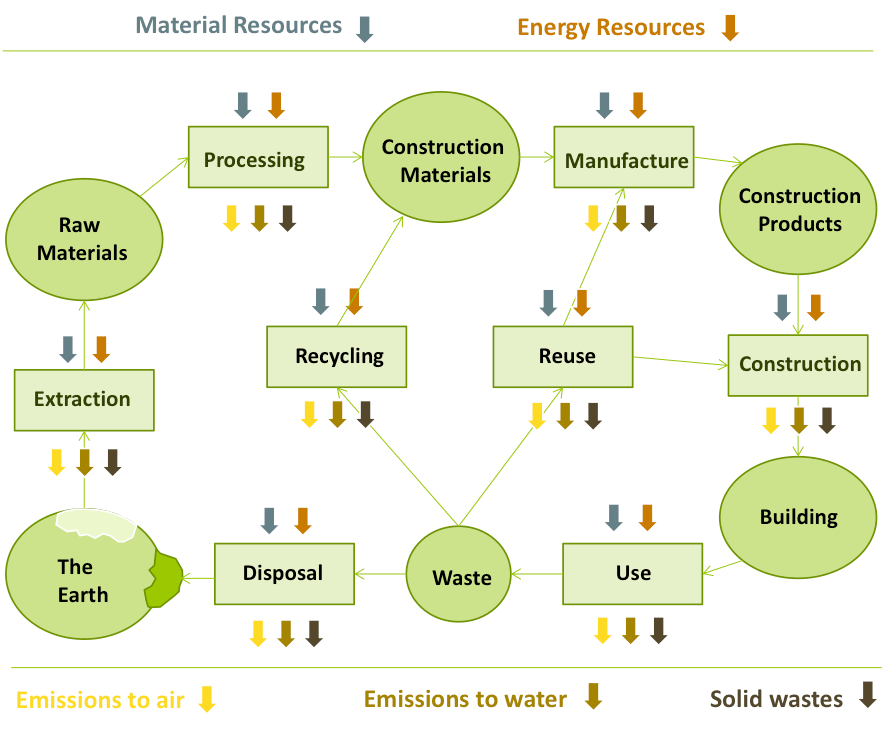Data on the environmental impacts of buildings is generally consistent throughout the world [World Watch 1995, UNEP 2009]. The construction and operation of buildings account for approximately 40% of the global energy use. For the OECD nations only, about 25% to 40% of anthropogenic greenhouse gas emissions are related to buildings; 40% to 95% of these emissions are caused by operational energy use with the remainder being caused by construction and demolition [de Wilde and Coley 2012].
Building and construction in general embody burdens (energy, resources, and emissions) beyond the simple resources accounted for in the construction quantity take off. For example, they embodied energy which is the sum of all the energy required to extract, transport, process, and manufacture all the products used in a building plus the energy used to build it. To reduce the environmental impacts, the construction industry has slowly been transitioning from a linear construction process into cyclic one, with the intent to replace the use of raw materials with reused and recycled ones.
In addition to reducing non-renewable resource depletion, the cyclic process reduces habitat alteration, as well as the energy and emissions associated with the extraction and processing of raw resources.
The challenges of this transitioning are enormous as they imply changes in the way buildings are conceived, built, operated and maintained. Design approaches such as design for deconstruction (or design for disassembly) are being used more often [Kibert 2003]. In addition, new products are being developed based on renewable materials; while others are being promoted for enhancing operational performance, i.e. energy efficiency, indoor air quality, durability, etc. resulting in even greater environmental benefits. The uncertainties, however, arising from the multiple exogenous factors involved and the long term implications need to be assessed.
Moreover, climate change is one of the main challenges facing humankind in the 21st century. The performance of buildings depends on the climate they are exposed to. Their long life-time corresponds to the timescale to which the climate is expected to show substantial change [de Wilde and Coley 2012].
The Factor Four initiative at BCIT
Construction and demolition of buildings creates a tremendous amount of waste. Modular building techniques that enable design for deconstruction can help reduce the amount of waste that is generated when a building is demolished. A long term goal for the building industry is to achieve zero waste resulting from the built environment.
Three buildings in the Factor Four initiative (NE2, NE4 and NE6) are constructed entirely from re-purposed building materials. These buildings were originally constructed for use as hangers in the United Kingdom. After the end of World War II the buildings were deconstructed and the materials were sent to British Columbia, Canada for reconstruction as our Joinery (NE2), Carpentry (NE4) and Piping (NE6) educational buildings on BCIT’s Burnaby Campus. That means the buildings have enjoyed a very long lifecycle and as a result they have super low embodied energy.
BCIT’s Building Science Centre and the Graduate Degree Program in Building Science have sustainability as a core value. Courses are offered that incorporate aspects such as the durability and life-cycle assessment of materials (BSCI 9020 Building Materials, BSCI 9000 Building Science 1), materials emissions and indoor air quality (BSCI 9170 Ventilation and Indoor Air Quality), energy efficiency and renewable energy technologies (BSCI 9130 Building Energy Performance), and passive design (BSCI 9100 Building Science 2). Applied research on alternative building materials, such as phase-change materials, and the integration of more climate-responsive building technologies, such as advanced glazing technologies, is also being undertaken.
The School of Construction and the Environment’s Civil Engineering Program also conducts applied research to test the strength and durability of various building materials including structural concrete and pervious pavement.
History
Incorporating sustainability in the materials used to deliver BCIT educational programs can be traced to efforts by BCIT’s Joinery Program which in 2006 decided to begin phasing out all toxic substances and increase the use of Forest Stewardship Council certified wood. Today, the Joinery Program only uses water-based solvents and non-added ureah formaldehyde products. This means that the students learn in a toxic-free environment, their projects (cabinetry and furniture) is low-impact to the environment, and the wood waste generated from their educational activities is clean.
Links:
References
De Wilde and Coley (2012). The Implications of a Changing Climate for Buildings; Journal of Building and Environment, Vol. 55, Elsevier, pp. 1-7.
Kibert C. (2003). Deconstruction: the Start of a Sustainable Materials Strategy for the Built Environment; UNEP Industry and Environment, April – September 2003.
UNEP (2009). United Nations Environment Programme (UNEP). Buildings and Climate Change: Summary forDecision-Makers; UNEP Sustainable Building and Climate Initiative: Paris, France, 2009; pp. 2–11. Available online: http://www.unep.org/sbci/pdfs/SBCI-BCCSummary.pdf (accessed on November 2012).
World Watch (1995). Worldwatch Paper #124: A Building Revolution: How Ecology and Health Concerns Are Transforming Construction; by David Malin Roodman and Nicholas Lenssen.

